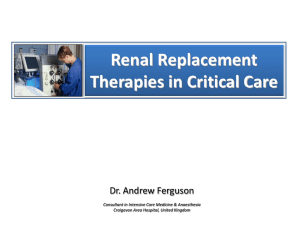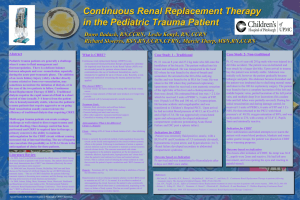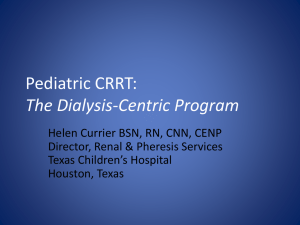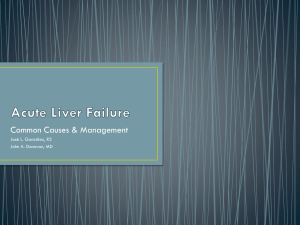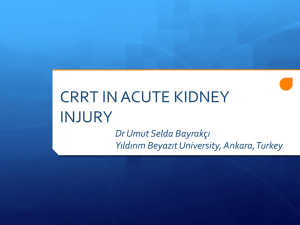CRRT in Liver Disease - Pediatric Continuous Renal Replacement
advertisement
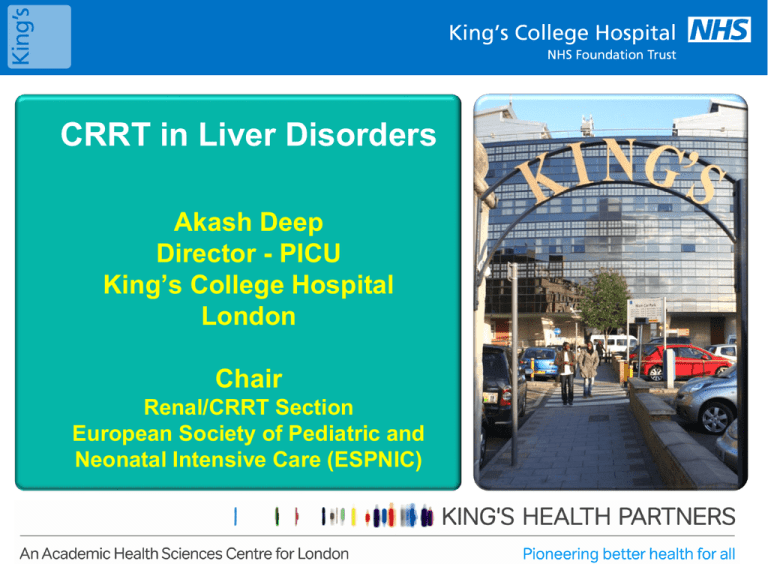
CRRT in Liver Disorders Akash Deep Director - PICU King’s College Hospital London Chair Renal/CRRT Section European Society of Pediatric and Neonatal Intensive Care (ESPNIC) 0 Children’s Critical Care Centre 1 Overview • Case Discussion • CRRT and AKI in ALF • CRRT in various Liver Disorders – Why AKI, When do you intervene, outcome • Single Pass Albumin Dialysis (SPAD)/ MARS • Anticoagulation in liver Patients 2 RRT in liver patients •ALF •Stable cirrhosis •AoCLF •Post Liver Transplant •Metabolic diseasehyperammonaemia, primary hyperoxaluria •CRRT – standard ICU indications in patients with liver disease Survival in patients treated by RRT according to diagnoses: ppCRRT Registry Symons, Clin J Am Soc Nephrol, 2: 732, 2007 100 90 80 Overall survival 58% 70 60 50 40 30 20 10 is m ab ol er ro D ro ru g in fm et to xi c ys i s at io S n d nc y ig na M al y ar on ul m pCCRT Rome 2010 In bo rn P Tu m or L T M B se D is ea ea se er d Li v di al en R is se ea D is ac di ar C as e se ck /s ho Is ch em ia S ep si s 0 4 Case - 1 • • • • • • • 9 year old previously well child from Dublin 4 day history of cough, fever Recovered 2 weeks later – lethargy, jaundice Readmitted to hospital Increasing Jaundice, raised INR, fully alert Diagnosis??? 5 KCH • Admission to King’s Hepatology Ward • INR > 9, Listed for super-urgent liver transplantation • Overnight – going in and out of sleep, decreased urine output, 3 fluid boluses • All alarm bells ringing • It was the weekend!!!!!! 6 Paediatric PICU • • • • • Patient wheeled to ICU Distinctly looked encephalopathic INR 7.8 Platelets 13 Hb 7.8 Ammonia – 178 micromol/litre Waiting for things to get ready – Transcranial Dopplers done- PI > 2.0 7 Raised ICP results in reduced diastolic flow, PI 2.4 PICU Care • • • • Intubated ventilated Inserted 12.0 F IJV vascath Right Reversed Internal Jugular Vein Right Femoral CVL and Left Femoral Arterial Line • NIRS started • Bilateral Pleural effusions – drains inserted 9 PICU ( 11:00 -13:00) • Within 60 minutes – HVHF started • Pump speed – 250 mls/min, Predilution- 2.5 litres, ACT- 200 Started on PGI2 – 4ng/kg/min • Ph 7.10 CO2-5.5 kpa Lactate 5.6 Base deficit- 14.1 Cl- 110 • Vasopressor support + 60 mls/kg Fluid • Steroids given • FFP+ Platelets+ Activated Factor –VII • Fentanyl + Midazolam started • Phenytoin loading given, hypertonic saline 10 infusion Neuro- monitoring • • • • • TCD – PI- 2.4 RIJV – 42% NIRS correlating with RIJV Hb -10, CI 4.2 on vasopressor support DECISION TO INSERT ICP BOLT 11 Neuroprotection ( 13:30) • Inserted a Camino epidural bolt- scalp bleeding for > 30 minutes • Opening pressure – 50 cm H2O • Immediately started hypothermia ( 32 degrees), full neuro-protection including thiopentone infusion with continuous EEG • ICP minimum – 45 cm H20 with good waveform 12 Case - continued • At 2 am- when every possible neuroprotection was thrown at her – Called the surgeon • Anhepatic – No sign of liver coming up, father had fatty liver • CRRT continued in OR for 16 hours • Increased turnover to 4 litres/hour 13 Temporary anhepatic state 14 Case ( 13:00) • Within 8 hours – cadaveric liver transplantation done ( liver not of great quality- but used as a bridge ) • Patient re-listed for another transplant • Complete normal neurology • Re-transplanted in 4 weeks • Progressive kidney involvement- Urea, creatinin``e, K rising and fluid overload • On CRRT from 28/7/12 till 24/01/2013 • Gradually weaned off CRRT 15 Progress • • • • • Progressive BM Suppression and CKD Listed for BM transplant Went on to IHD Developed disseminated aspergillosis Sadly WG RIP on 28/02/2013 16 Questions • Why did WG develop AKI in ALF? • Could we have acted more swiftly and started CRRT overnight – i.e, what is the exact time of initiation of CRRT? • What was our aim of starting CRRT? • The fact that she was neurologically completely intact – Did CRRT help or was it the aggressive neuro-protection? 17 CRRT in ALF 18 Liver can Regenerate!!! Pierre Paul Rubens Chained Prometheus The Philadelphia Museum of Art Ultimate Aim of RRT in ALF Conducive Environment for Either Liver Regeneration /Liver Transplant – Stable haemodynamics, removal of toxins, CPP •The potential for recovery of native organ function •Too little donor organ pool •To prolong the window of opportunity for LT : “Bridge to LT” • Risk of death awaiting liver transplant ( MODS) – Fluid manipulation, acid-base, ammonia, nutrition Liver Support Devices until recovery from ALF or bridging to transplant. Hepatology 1998:27:1050-5 King’s College Hospital PICU Admissions Jan 2003- Dec 2013 EXCLUDED: Acute on chronic (5%) Liver n=1289 (18%) ALF n=165 (13%) EXCLUDED: Post-transplant (18%) Primary HSV sepsis (5%) HDU (13%) Managed prior to transplant/recovery n=106 (64%) with CRRT n=45 (42%) 25 Distribution by Age and Aetiology 20 Ischaemic 15 Autoimmune Wilson's disease Haematological malignancy Neonatal haemochromatosis 10 Infectious Metabolic Drug induced Indeterminate 5 Mean PIM2 score = 54 0 <28days 28days-1yr 1-2yrs 2-5yrs 5-10yrs 10-18yrs Use of CRRT in Paediatric ALF at KCH • Average time to start CRRT 29 hrs (1 in 3 <8hrs) • Commonest indication hepatic encephalopathy • 100% required mechanical ventilation • 93% required ionotropes • Mean duration of CRRT was 54 hours. Mean Ammonia (umol/L) in Relation to CRRT in ALF PICU Patients by Outcome on Discharge n=45 Mean Lactate (umol/L) in Relation to CRRT in ALF PICU Patients by Outcome on Discharge n=45 Mean Fluid Overload (%) in Relation to CRRT in ALF PICU Patients by Outcome on Discharge H24 H48 H48 40 40 40 20 20 40 20 0 0 -20 -20 -40 -40 -60 -60 -80 -60 -80 -60 -40 -40 -20 0 -20 0 20 -80 Variation in serum creatinine, % H24 P= 0.0002 -80 Variation in Creat, % Variation in Creat, % p=0.002 H48 80 80 60 60 60 40 40 20 20 0 0 20 0 0 20 40 40 60 80 80 H24 -20 -20 -20 -20 -40 -40 -40 -40 Variation in mean arterial pressure , % p=0.0002 P=0.0002 P=0.0005 p=0.0002 p=0.0005 Variation in PAM, % Variation in PAM, % Variation in hepatic encephalopathy grade P= 0.002 At 24 hours: Increase MAP (p=0.0002) Decrease serum creatinine (p=0.0002) H24 H48 8 8 6 6 4 4 2 2 0 0 2 - 2 - 4 - 4 - P= 0.90 p=0.90 Variation in Encephalopathy grade P= 0.04 p=0.04 Variation in Encephalopathy grade At 48 hours: Increase MAP (p=0.0002) Decrease serum creatinine (p=0.0002) HE grade improvement (p=0.04) Effect on outcome of CVVH Cumulative Survival 1 ,8 ,6 ,4 < 1 year ,2 > 1 year HV- CVVH era 2002-2008 HV- CVVH era 2002-2008 0 0 10 20 30 40 Days 50 60 70 80 No effect on long term survival, but significant prolonged initial delay Cumulative Survival 1 ,8 ,6 ,4 < 1 year ,2 > 1 year HV- CVVH era 2002-2008 HV- CVVH era 2002-2008 0 0 10 20 30 40 Days 50 60 70 80 Conclusion CVVH in Paediatric ALF • Improved hemodynamic, renal and neurological function • Allows a prolonged period of stability to ELT Renal Support in Liver Failure • Why do patients with Liver failure develop AKI? • Why do patients with AKI in liver failure require RRT /detoxification modalities? • What is the best time to initiate RRT in patients with ALF? • Elective versus standard CRRT • What dose of RRT is the best dose – role of HVHF? • Anticoagulation in CRRT for ALF 31 Pathogenesis of AKI in ALF Arterial vasodilatation (‘’VASOPLEGIA’’) Decreased SVR High Cardiac Output Renal Auto-regulation becomes Pressure Dependent - Intra-renal Vasoconstriction 32 Aetiology of Kidney Involvement in ALF • Multifactorial • Pre-renal AKI • Acute tubular necrosis due to profound hypovolemia and hypotension • Direct drug nephrotoxicity (paracetamol, NSAIDs) • Hepatorenal syndrome • Intra-abdominal hypertension (IAH) and development of abdominal compartment syndrome - USCOM 34 Renal • Renal replacement therapy in ALF – Continuous filtration not intermittent dialysis • Improved metabolic stability • Improved cardiovascular stability Davenport et al Crit Care Med 1993;21:328-338 – Additional benefits from high filtration rates ? • 35 ml/kg/h as standard. • 90ml/kg/h severe lactic acidosis ++ vasopressors. • We use minimum of 60 mls/kg /hour and increase if lactate/ammonia not getting better NH4 cut off 124 : pH, cerebral oedema + NH4 predict outcome Bhatia V Gut 2005 Patients who develop ICH tend to have persistently high ammonia levels. Bernal W Hepatology 2007 Evidence for Ammonia Comparison of arterial ammonia levels at admission between survivors and non‐ survivors among acute liver failure patients Gut. 2006 January; 55(1): 98–104 Mortality, advanced encephalopathy, and complications in acute liver failure patients as a function of plasma ammonia levels Parameter Ammonia Ammonia <124 μmol/l (n=38) 124 μmol/l (n=42) p Value Mortality 9 (23.7) 33 (78.6) <0.001 Renal failure 1 (2.7) 10 (23.3) 0.009 Ventilation 10 (27.0) 30 (69.8) <0.001 Infection 19 (51.4) 28 (65.1) 0.212 Cerebral oedema 8 (21.6) 20 (46.5) 0.020 Encephalopathy grade (3/4) 23 (62.2) 35 (81.4) 0.055 Seizures 3 (8) 15 (35) 0.006 Higher percentages of cerebral oedema (71% vs 37%; P < .001) Gut. 2006 January; 55(1): 98–104 Clin Gastroenterol Hepatol. 2012 Aug;10(8):925-31 Timing of Initiation of RRT • Do NOT wait for frank signs of renal failure • Metabolic complications - metabolic acidosis, lactate, hyponatraemia and NH3 >150 µmol/litre • If child intubated for grade ¾ encephalopathy – insert vascath • Challenges – High INR, potential for bleeding and vascath complications 42 43 Authors – Akash Deep, Anil Dhawan RRT – Indications in ALF • Hepatic encephalopathy grade 3-4 • NH3 >150 µmol/litre and not getting controlled or an absolute value >200 µmol/litre • Renal dysfunction (Oligo-anuria, Hyperkalemia, fluid overload) • Metabolic abnormalities ( hyponatremia Na <125 meq/litre, High lactate and increasing despite optimising fluid therapy, Metabolic acidosis) No one indication is an absolute one for initiation of RRT 45 If Early HVHF looks promising, what are the potential drawbacks? • Invasive procedure • Haemodynamic instability, decreased cerebral perfusion • Clearance of medications • Side effects Acute kidney injury in patients admitted to a liver intensive therapy unit. O’Riordan A • 2000-2007 : 302 ALF managed without OLT • 21% did not develop AKI : all survived • 239 with AKI of whom 164 survived(68%) – LOS increased by 5 -7 days • 51% return of normal renal function • eGFR > 60 at time of discharge Nephrol Dial Transplant. 2011 Nov;26(11):3501-8. 48 49 SUMMARY No Evidence for RRT in Liver patients Should we undertake CRRT in ALF • Yes - and review : population data vs individual care Why ? –Neuro-protection, metabolic disarray, bridge for recovery or transplant When • Earlier - need new markers Mode • CRRT - unstable Access sites • Internal Jugular Dose • No evidence in Paediatrics •High /Low - No Adequate - yes Anticoagulation - YES •PGI2 and /or low dose heparin AKI in Chronic Liver Disease 51 Progress of cirrhosis 52 Kidney dysfunction in cirrhosis Natural Progression of disease complications Renal dysfunction HRS V/s Stable patient with cirrhosis, PHT precipitating event HRS-1 53 AKI in Liver disease • Is every AKI in liver disease HRS ? • What are the different causes of AKI in liver disease? • Can we reliably differentiate between the various causes of AKI? 55 Frequent causes of AKI in CLD • Hypovolaemia: GI bleeding – (don’t forget the ulcer ) GI fluid losses (Lactulose, Terlipressin, PPI, GI infection) Diuretics abuse/over use • Parenchymal disease: GN, Cryoglobulinaemia, IgA nephropathy – Biopsy? ATN/HRS • Drugs: CIN, NSAIDS, Abx, CNI post Tx • Intra Abdominal Hypertension • Hepato-renal Syndrome Epidemiology • 50% of patients with cirrhosis with ascites will develop AKI • HRS constitutes a very small proportion of AKI in cirrhosis • ONLY 7.6% of all 129 cirrhotics with AKI had HRS as the cause of deterioration (Montoliu S, Ballesté B, Planas R, et al ) • Multicentre trial – 423 patients with cirrhosis and AKI (ATN -35%, Pre-renal failure-32%, HRS-1- 20%, HRS-2 6.6% (Moreau R, Durand F, Poynard T, et al) Creatinine >1 .5 mg/dl 463 patients over 6 years Single centre 3 month mortality Renal Replacement therapy • Mainstay of supportive therapy for patients who deteriorate despite aggressive resuscitation • Volume overload, intractable metabolic acidosis, and hyperkalemia • Delay in RRT – MORTALITY > 90% • High risk in hepatic encephalopathy, hypotension, and coagulopathy • Serves as bridge to transplant • If RRT > 8 weeks before LT - ???? Combined LiverKidney Transplantation Kidney Dysfunction post Transplant • AoCLD or ALF with raised ICP pretransplant • Pre-transplant - Renal Dysfunction • Intra-operative factors – Haemorrhage, hypotension after graft reperfusion, requirement for blood transfusion, IVC clamping • Post operative : Hypotension, nephrotoxic drugs ( immuno suppression, antibiotics) 60 61 Metabolic Disease • Hyperammonaemia of the newborn – UCD, citrullinaemia, Propionic acidaemia • Primary Hyperoxaluria • Collapsed newborn – postnatal diagnosis ( prognosis, ethical issues) • Antenatal UCD diagnosis – Hepatocyte transplantation and more controlled lowering of NH3 • Modality – CVVH versus CVVHD versus CVVHDF 62 1. Time critical (get patient to your PICU) • Time to make diagnosis • Time to transfer to PICU • Time to start medical detox 2. Secure IV access for dialysis • Largest vascath possible • Best site (least recirculation) • Peritoneal dialysis may by time 3. Time of effective dialysis • Mode dialysis you are familiar with • Circuit downtime Dialysis for inborn errors – Technically challenging – Time critical – No room for error – Make sure you have right diagnosis – Does not always work if production toxins extreme 65 Sauer et al 2004: SPAD In Vitro In vitro samples: 6 pts with MARS, 6 SPAD, 6 CVVHDF Ammonia - No difference between MARS, SPAD, CVVHDF Bile Acids - MARS = SPAD Total Bilirubin - SPAD > MARS 66 MARS 68 Anticoagulation Anticoagulation in RRT in liver patients – is it different ? 69 Liver Failure • Bleeding in ALF – defective synthesis of both pro and anti- coagulation factors • Conventional forms of anticoagulation contraindicated in patients with a high risk of bleeding (Coagulopathic, decreased metabolic clearance of citrate, enhanced bleeding risk) • Monitoring of heparin liver failure – tricky( Factor-8 and vwF increased) • Should CRRT circuits in patients with hepatic failure be anti-coagulated? endogenous thrombin potential ratio (ETP) suggesting hypercoagulability. 71 • Retrospective analysis of 50 patients – Acute liver failure – Acute on chronic liver disease – Post-elective liver transplantation • Comparison groups – Sepsis – Hematological malignancies • No ACG initially • Outcomes – Mean circuit life – # circuits per 48 hours On starting ACG in patients with liver failure filter life increased from 5.6 to 19 hours. There was no increased bleeding or requirement for blood transfusions Patients with liver disease contrary to common belief do require anticoagulation to keep CRRT going continuously Treatment options • Low dose Heparin • Prostacyclin • Citrate ??? 74 Anticoagulation in CRRT for ALF • Depending on ACT • No Anticoagulation: If ACT >220 sec. • Prostacycline : If ACT between 180-220 Sec • Low Dose Heparin: If ACT < 180 sec. If ACT persistently low, patient is septic – combination of low dose heparin and prostacycline 75 Heparin and Prostacyclin combined HEPARIN PROSTACYCLIN 76 Safety and Efficacy of Prostacyclin as an anticoagulant in CRRT in patients with ALF • First ever Paediatric data (King’s PICU) • 3 year period ( 2011-2013) • All children with ALF on CRRT ( n=76) • Efficacy Filter life Mortality • Safety Bleeding episodes during CVVH Hypotension ( requirement for fluids/vasopressors) Platelet consumption Epoprostenol ( n= 45)versus Heparin ( n=26) 77 Dialysed children 76 Total filters used 210 (Prostacyclin 127, Heparin 45, None- 38) Target event – clotted filter Censored – filter removed due to other reasons CRRT in Liver Disease • Different from non-liver ICU patients Indications Timing ?Dose – Role of HVHF Anticoagulation 79 Liver pCRRT Registry at KCH • PICU ALF registry at KCH Every patient gets a standard documentation of all parameters • Liver pCRRT Registry – All patients with liver disease on CRRT(mode, indication, dose, filter size, biochemical markers, pre/post dilution, ACG, outcome etc etc) • Protocol Development – CRRT, hyperammonaemia, ACG 464 variables measured per patient Treat the kidneys early Large blood volume - all in the wrong space ! Large volume of distribution Reversal of neurological dysfunction Need more studies

